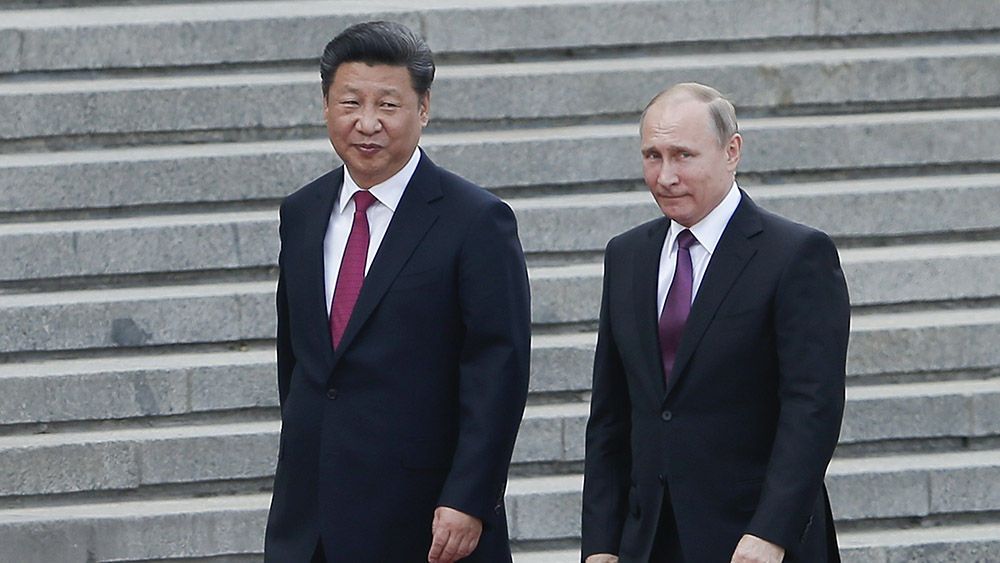Trump's using a clever trick to break the Deep State's massive 'command and control' system…
By newseditors // 2025-02-09
Tweet
Share
Copy

Every once in a while, you come across something online that just nails it. This is one of those times. We found an analysis of the Deep State “command and control system” that will blow you away.
(Article republished from Revolver.news)
Yes, we all know the media is in bed with the regime, the Deep State, and every other corrupt power entity, right? But there’s more to it than you might think. In this really weird way, this is an issue that’s both more complicated and less complicated at the same time.
Now for the good news—President Trump has found a clever way to break down this massive, intricate apparatus, and as we speak, it’s crumbling. More on that later.
That’s the positive. But there are plenty of negatives too, more on that later, as well.
Before we get into the nitty gritty and share this incredible analysis with you, let’s take a step back and lay the groundwork for how the Deep State’s “command and control” system really operates.
Most of us know all about the “fake news” pipeline, but what we don’t realize is how it actually works. People love to joke about CNN being the “CIA News Network,” and honestly, they’re probably not too far off. But the way this whole operation plays out is fascinating, chilling—and very telling.
And to understand how Trump just broke it, you first need to get a solid grasp on how the machine actually runs. No, it’s not some shadowy figure in a dark, smoke-filled office making phone calls to handpick news stories for the left. It’s a lot more intricate, detailed, and clever than that.
There’s a very precise system in place, designed to make so-called “journalists” and editors believe they’re actually doing real journalism. That illusion is key. If the pawns start to question their own role, the whole scheme falls apart. Keeping them convinced they’re professionals is what makes this machine run like a well-oiled propaganda factory.
So, without further ado, here’s one of the best breakdowns of the Deep State’s media control center—and how President Trump just shattered it, leaving the players confused and scrambling for answers.
John A. Konrad:
I opened my NYTimes app today. They’re trying, but they can’t keep up. News that broke just hours ago is already off the homepage. THIS IS CRUCIAL The entire liberal deep state command and control system is broken. Let me explain ? The NYTimes’ primary function isn’t journalism. It’s narrative coordination—setting the frame so the entire political-media machine knows how to think about an issue before it takes off. Ever notice how, overnight, everyone starts saying “Biden is sharp as a tack” or “JD Vance is weird”? It’s not random. It’s a system. The Narrative Pipeline: How The Blob Operates The NYTimes, NPR, WaPo, CNN, and the rest don’t just react to news. They function as a distributed, decentralized mission command system for the Democratic Party and the broader Blob. Step 1: Local Bureau Chiefs – These guys are stationed across the country, watching which stories gain traction and fielding calls from Dem operatives feeding them narratives. Stories that they need to start controlling Step 2: New York Editors – Bureau chiefs snip the news and send it to NY, where an editor triages it: •Will this explode nationwide? •Will it simmer for days? •Or should we bury it? Step 3: Editorial Meeting – The most concerning stories get flagged. Here, editors decide on the narrative framing and who to assign to write it. But before they assign a journalist, they make one critical call—to the Deep State. Why? To give the government a head start on controlling the story. At this point, the Deep State doesn’t just say, “Here’s what happened.” They strategically select sources based on the tone they want. •If they need hawkish China rhetoric, they have a “China hardliner” expert on speed dial. •If they want to downplay a Chinese spy scandal, they go to a “dovish” China expert who will say it’s being blown out of proportion. •If it’s a military scandal, they pick a “trustworthy” retired general to subtly steer the discussion toward a desired conclusion. This isn’t journalism—it’s perception warfare. Once the tone is set, the editor assigns the story and suggests the approved sources to call. The journalist’s job is simple: •Get quotes from the right experts. •Write it up. •Stick to the approved angles If something goes wrong with the angle (e.g. a source exposes it as a lie) they return to the editor for “guidance.” Occasionally, a journalist oversteps. If it’s minor, it passes. If it’s major, the editor kills the piece, buries it on page 16, or reassigns it to a more trusted writer to “correct” the framing. Overstep too many times and your reassigned to local news or gently (it’s not your fault, we LOVE your spark, just downsizing) let go. Do a really good job sticking to the approved script you’ll get awards or book deals and travel assignments. Nobody flatly says “this award isn’t for toeing the party line” because that would expose the scam. No, these journalist are smart. They either pick up on the reward incentives or they are gently pushed aside. Suddenly, every news outlet, late-night host, and blue check is reinforcing the same message. And because they aren’t technically taking orders, they think it’s their own independent analysis. This is why the narrative feels so unified. No one’s forcing compliance—it’s a system that rewards alignment. Now each individual pundit and blog is allowed to post independently but they all know unconsciously to work the narrative because that’s where the rewards are. If someone breaks the narrative in a bug way intentionally there are three options: 1) smear campaign to make them toxic 2) ban them from the system (wikipedia blacklist, social media throttle, no DC party invites, no pentagon press pass, etc) 3) turn them into a double agent who claims to buck the narrative but subtly shifts things left (@bariweiss is the ultimate genius at this) Not all stories emerge organically. Sometimes, the Deep State calls first. •A senior editor gets a call: •“Everyone in DC is talking about how weird JD Vance is.” •The next morning, at the editorial meeting, that becomes: •“People are saying JD Vance is weird. Let’s get some stories on that.” •Then every editor repeats it to their reporters: •“Did you hear JD Vance is weird? Let’s explore that.” Suddenly, every news outlet, late-night host, and blue check is reinforcing the same message. And because they aren’t technically taking orders, they think it’s their own independent analysis. This is why the narrative feels so unified. No one’s forcing compliance—it’s a system that rewards alignment. The deep state tries its best to play a soft hand. They let things emerge around the narrative and only step in if the narrative is evolving in a bad way or new information disturbs the narrative. So where does this organic command and control system come from? Well, the military, of course. Why This Matters: The Mission Command Model This decentralized coordination mirrors how the best militaries operate—through a doctrine called Mission Command. A bad general micromanages: •“Move three platoons and six tanks around this road and attack the base.” A good general gives flexibility: •“Take this logistics base by X time. Figure out the best way.” A great general sets intent: •“We need to cripple their supply lines. Here’s what we know about their logistics.” The best commanders set objectives, not orders—then let their officers adapt on the ground. This is exactly how the NYTimes and the Blob operate. They don’t give direct orders to every outlet. They set the intent—how the political-media machine should think about an issue. Then, think tanks, columnists, TV hosts, and activists execute their own variations of the message. Why Republicans Keep Losing the Narrative War Republicans don’t have this. •No clear commander’s intent. •No unified messaging framework. •No ecosystem where think tanks, media, and party strategists move in the same direction. Instead, it’s chaotic, reactive, and uncoordinated. Meanwhile, Democrats operate like a well-oiled Mission Command system—not because of a single top-down controller, but because every key player understands their role in pushing the message. And until Republicans build a competing system, they’ll always be playing defense.That last part is the most important. Trump’s rapid-fire style isn’t just effective—it’s a wrecking ball to their machine, and he needs to keep it up. With the disaster this country is in, that shouldn’t be too hard. But here’s the real takeaway: we need our own command system. No more of this “high road” nonsense, where we sit on the sidelines like Paul Ryan, clutching our pearls and mumbling, “That’s not who we are…” Meanwhile, the left plays dirty, and they win, and win, and win, and win. We need a system that beats them at their own game and gets our message out to the American people. Social media has been a game-changer for us, which is exactly why the left is so desperate to censor and control the internet. We’ve built a solid base there, but it’s not enough. If we want to stay competitive in this brutal political landscape, we have to go bigger. Because like it or not, this battlefield isn’t changing anytime soon. We encourage you to read the entire analysis. You can do so by clicking here. Read more at: Revolver.news
Tweet
Share
Copy
Tagged Under:
Donald Trump government mainstream media Republicans politics democrats fake news deep state journalism
You Might Also Like
The Jewish Radicals: A history of Revisionist Zionism and its controversial legacy
By Arsenio Toledo // Share
Netanyahu vows to “open the gates of hell” if Hamas fails to release all hostages
By Cassie B. // Share
Trump’s Victory Triggers ‘Great Reveal,’ Exposes Deep State Corruption
By Finn Heartley // Share
Europe told to brace for flood of Ukrainian soldiers with PTSD
By News Editors // Share
Recent News
Xi Jinping: Russia-Ukraine war can only be resolved by addressing its "root causes"
By ramontomeydw // Share











